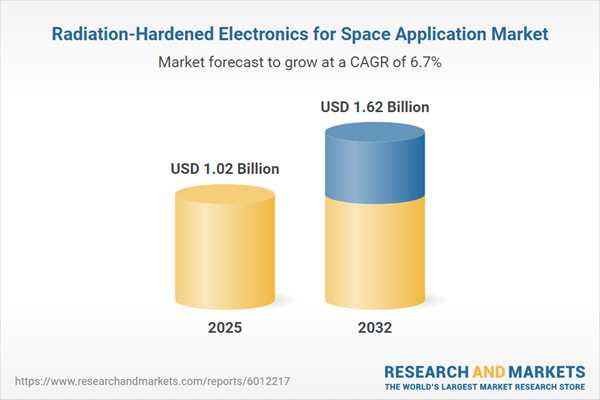Speak directly to the analyst to clarify any post sales queries you may have.
Radiation-hardened electronics play a pivotal role in enabling reliable mission-critical operations and resilient system performance across the rapidly expanding space sector. As stakeholder requirements and operational environments grow more complex, decision-makers must adopt forward-thinking strategies to navigate technical, regulatory, and supply chain challenges.
Market Snapshot: Radiation-Hardened Electronics for Space Applications
In 2024, the radiation-hardened electronics market for space applications achieved a valuation of USD 962.92 million, propelled by a 6.73% compound annual growth rate. This growth is driven by expanding satellite networks and intensifying space exploration efforts. Advances in electronics miniaturization, digitization, and integration are notably enhancing the performance and efficiency of spacecraft systems. Companies in this sector are prioritizing resilient supply chains and sustained operational continuity to support the intricate technical demands of orbital and deep-space missions. Collaborative advancements are fostering the swift introduction of specialized products to address evolving mission requirements and operational scenarios.
Scope & Segmentation of the Radiation-Hardened Electronics Market
- Product Types: Analog integrated circuits provide secure signal processing vital for spacecraft controls; field-programmable gate arrays, including antifuse, flash, and SRAM variants, support in-mission reconfiguration capabilities; memory solutions such as EEPROM, SDRAM, and SRAM are engineered for data integrity in hostile conditions; microcontrollers allow efficient integration of complex onboard subsystems; power management ICs, including voltage regulators and DC-DC converters, are required for stable energy distribution; environmental sensors, namely accelerometers, magnetometers, gyroscopes, and temperature sensors, deliver critical mission telemetry and enhance navigational accuracy.
- Applications: Used across deep space probes, communications satellites, scientific research platforms, navigation satellites, terrestrial support, custom payloads, and modular mission designs where both human and robotic systems demand reliable electronic infrastructure.
- End Users: Commercial equipment manufacturers, defense entities, and space agencies each require solutions compatible with harsh environments and compliant with rigorous technical standards.
- Radiation Tolerance Levels: Devices are offered in high, medium, and low tolerance variants, empowering designers to match system protection to mission-specific radiation environments, from low-Earth orbit to interplanetary travel.
- Geographic Regions: The Americas and Europe lead innovation, system design, and technical standardization; Asia-Pacific is building out fast, leveraging expansive manufacturing capacity and agile supply chains; the Middle East and Africa invest in new space infrastructure projects and collaborative research, strengthening global market connectivity.
- Leading Companies: Industry leaders such as Microchip Technology, Teledyne Technologies, Analog Devices, Texas Instruments, BAE Systems, L3Harris Technologies, Honeywell International, Northrop Grumman, STMicroelectronics, and Airbus maintain supply chain continuity, shape evolving standards, and drive strategic product developments.
Key Takeaways for Senior Decision-Makers
- Rigorous qualification and testing protocols strengthen trust among stakeholders and ensure electronics meet multifaceted mission and compliance requirements.
- Ongoing advancements in miniaturization and integrated electronic systems expand operational flexibility, supporting more adaptive mission planning and streamlined payload architectures.
- Collaboration among manufacturers, regulatory organizations, and research institutions accelerates technical innovation while enabling scalable and efficient production to address diverse operational demands.
- Open-system and modular design strategies increase cost efficiency and simplify the adoption of new technologies while supporting effective lifecycle management of assets in orbit.
- Expanding the manufacturing footprint, especially in Asia-Pacific, reduces supply chain risks resulting from global disruptions or policy changes and enhances organizational resilience during project execution.
Tariff Impact: Shifting Supply Chain Strategy
Recent modifications to United States tariffs on semiconductor imports are prompting industry leaders to reevaluate sourcing, supplier relationships, and assembly locations for radiation-hardened electronics. Increased focus on domestic production channels and closer monitoring of strategic partners have become critical elements in supply risk management. These steps help ensure ongoing access to essential components even as international trade conditions shift.
Methodology & Data Sources
This analysis integrates perspectives from semiconductor engineers, mission planners, and key government stakeholders. Data is sourced from technical journals, regulatory documents, and expert review panels, guaranteeing that market trends and industry shifts are accurately represented based on the latest developments in radiation-hardened electronics.
Why This Report Matters
- Offers executive leadership clear insights to minimize operational risk and identify strategic opportunities within the evolving space electronics sector.
- Delivers actionable market segmentation to guide budget allocation and investment planning across target applications, customer segments, and global regions.
- Equips procurement and compliance teams to anticipate and adapt to regulatory change and evolving supply chain dynamics, enabling steadfast responses to market fluctuations.
Conclusion
This report enables senior leaders to optimize procurement practices, prioritize long-term technology investments, and prepare organizations for future advancements as the space electronics landscape increases in complexity and strategic importance.
Additional Product Information:
- Purchase of this report includes 1 year online access with quarterly updates.
- This report can be updated on request. Please contact our Customer Experience team using the Ask a Question widget on our website.
Table of Contents
3. Executive Summary
4. Market Overview
7. Cumulative Impact of Artificial Intelligence 2025
Companies Mentioned
The companies profiled in this Radiation-Hardened Electronics for Space Application market report include:- Microchip Technology Incorporated
- Teledyne Technologies Incorporated
- Analog Devices, Inc.
- Texas Instruments Incorporated
- BAE Systems plc
- L3Harris Technologies, Inc.
- Honeywell International Inc.
- Northrop Grumman Corporation
- STMicroelectronics N.V.
- Airbus SE
Table Information
| Report Attribute | Details |
|---|---|
| No. of Pages | 181 |
| Published | October 2025 |
| Forecast Period | 2025 - 2032 |
| Estimated Market Value ( USD | $ 1.02 Billion |
| Forecasted Market Value ( USD | $ 1.62 Billion |
| Compound Annual Growth Rate | 6.7% |
| Regions Covered | Global |
| No. of Companies Mentioned | 10 |









